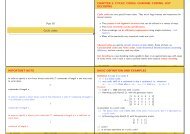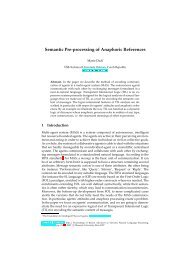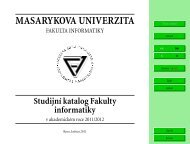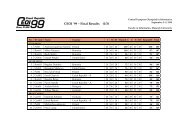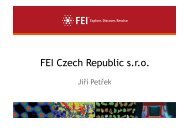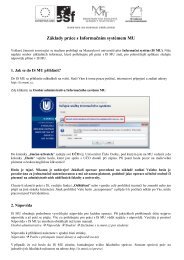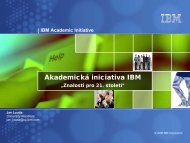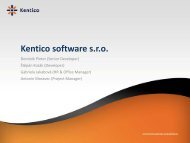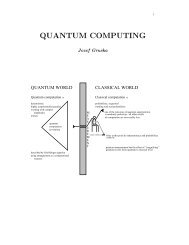The Encyclopedia Expert - Masaryk University
The Encyclopedia Expert - Masaryk University
The Encyclopedia Expert - Masaryk University
Create successful ePaper yourself
Turn your PDF publications into a flip-book with our unique Google optimized e-Paper software.
<strong>The</strong> <strong>Encyclopedia</strong> <strong>Expert</strong><br />
Zdeněk Svoboda<br />
April 5, 2002<br />
Abstract<br />
This paper describes the architecture and implementation of an open-domain question<br />
answering (QA) engine developed for the Czech language, using a general encyclopedia<br />
as the data source. Techniques from both the knowledge base systems and information<br />
retrieval systems are covered. Finally the evaluation results are presented.<br />
1 Introduction<br />
It is a well known fact that the amount of information in the society is rapidly growing. Besides<br />
the possitive impacts on our lives, this involves problems, such as information overload and<br />
low retrieval efficiency. <strong>The</strong> only way to address this problem is to develop sophisticated<br />
methods of information storage and natural methods of information retrieval.<br />
One of the most natural methods of information retrieval is the question answering (QA).<br />
It became more popular in the last years and many English speaking QA engines were developed.<br />
However there was no complex open-domain QA engine working with the Czech<br />
language until recently. <strong>The</strong> architecture of our engine was partially inspired by the general<br />
design of the QA engines, presented at the TREC 8 conference, particularly by the Lasso<br />
engine [1] and the AT&T engine [2]. This system was developed as a master thesis on the<br />
Faculty of Informatics in Brno in the year 2001. <strong>The</strong> original text of the thesis [3] (only in<br />
Czech) provides implementation details not covered by this paper due to the space limit.<br />
2 Preprocessing the text data<br />
<strong>The</strong> first step to be taken was to bring structure to the original raw text data file and to<br />
find a suitable method of indexing it for the purpose of QA. <strong>The</strong> encyclopedia was split to<br />
individual entries (and their meanings) and then we applied number of heuristic decision rules<br />
to identify the text fragments semantically corresponding to the entities MAN, COUNTRY,<br />
RIVER, MOUNTAIN, CITY and some of their attributes such as name, born, population,<br />
location, etc. This structure was captured using the XML markup language and the suitable<br />
DTD.<br />
<strong>The</strong> resulting tagged text was indexed in two manners. <strong>The</strong> first one borrows some features<br />
of the knowledge base QA systems. <strong>The</strong> second one makes use of the traditional vector space<br />
text indexing and retrieving concept.<br />
1
3 General overview of the engine architecture<br />
<strong>The</strong> input question proceeds sequentially through the chain of the engine modules. <strong>The</strong><br />
interface between modules is defined by XML tagging of the question. Now we describe the<br />
three main modules of the system — the taxonomy, the XML index and the IR index.<br />
3.1 <strong>The</strong> taxonomy<br />
We created a simple taxonomy, covering relatively wide area of possible questions. It’s purpose<br />
is primarily to determine the semantic type of the expected answer (eg. location, duration,<br />
currency, name, . . . ) and secondary to provide an extendable natural language interface for<br />
retrieving data with already known semantic types (as tagged in the XML structure).<br />
<strong>The</strong> database of patterns of the taxonomy is formed by several sets of regular expressions,<br />
each set corresponding to one possible answer type. <strong>The</strong> regular expressions from each set<br />
are sequentially applied to the input question until one of the patterns matches.<br />
Example of patterns (adapted for English):<br />
(when was)(.*)(born)<br />
(did)(.*)(already die)<br />
<strong>The</strong> ‘(.*)’ construct should capture the actual entity, corresponding to the object of the<br />
question. This captured entity can then be used as a query to the XML index.<br />
Each regular expression of the taxonomy can be optionally followed by the description (in<br />
a special query language) of the algorithm capable of retrieving the answer from the XML<br />
structure. <strong>The</strong> XML index module is bypassed if such an algorithm is missing.<br />
Example:<br />
(when was)(.*)(born) MAN name @birth date(MAN born)<br />
<strong>The</strong> final output from this module then looks like this:<br />
When was Jan Amos<br />
Komensk´y born<br />
3.2 <strong>The</strong> XML index<br />
<strong>The</strong> purpose of this module is to look up the object of the question in the corresponding<br />
index, to perform the retrieving algorithm and to provide an answer if nothing went wrong.<br />
For example, if we consider the question “When was Jan Amos Komensk´y born?”, the<br />
object of the question “Jan Amos Komensk´y” will be looked up in the contents of the ‘name’<br />
attributes of all tags. <strong>The</strong> corresponding ‘born’ tag (corresponding in the framework<br />
of the surrounding tag 1 ) will then be retrieved and prettyprinted by the<br />
‘birth date’ macro.<br />
<strong>The</strong>re are indexes such as MAN name, CITY name or COUNTRY capital that provide<br />
mapping of every occurence of the corresponding entity (like ‘the name of the MAN’) to the<br />
1 the tag encloses different possible meanings of an encyclopedia entry<br />
2
offset of it’s enclosing encyclopedia entry in the XML text file. <strong>The</strong> first part of the name<br />
allways indicates the XML tag and the second part the indexed attribute.<br />
All keys that we try for querying the hashes are derived from the object phrase as follows:<br />
Every word of the object phrase is normalized and converted to it’s lemma. <strong>The</strong>n for every<br />
word-rotation of the phrase all it’s possible word-prefixes are used to query the hash.<br />
<strong>The</strong> indexes are currently implemented as internal Perl hashes, what implies excellent<br />
retrieval speed, but using the SQL database would be more memory-efficient and would<br />
provide greater query abilities and strength of our ‘algorithm query language’.<br />
3.3 <strong>The</strong> IR index<br />
This module increases the overall robustness of the system. It is based on measuring similarity<br />
between words of the question and fragments of the encyclopedia, that could possibly contain<br />
the right answer.<br />
We have implemented two different methods for building a query from the input question.<br />
<strong>The</strong> first is extremely simple — the whole question phrase is taken as a query and presence<br />
of every word in retrieved documents is not demanded. <strong>The</strong> most 50 similar documents 2 (in<br />
the terms of slightly modified inner product similarity function of the CZIndex system [4])<br />
are retrieved. This method was, as expected, outperformed by the latter — feedback based,<br />
adapted from the AT&T engine [2].<br />
<strong>The</strong> second method picks a few ‘important’ words from the question as the query and<br />
demands the presence of all those words in the documents. <strong>The</strong> query is then optimized via<br />
a feedback-based iterative algorithm. <strong>The</strong> feedback is controlled by the amount of documents<br />
that would meet the requirement of the given query. <strong>The</strong> query words are beeing added or<br />
removed on the basis of several heuristic selection rules. Query that returns at least one<br />
document and at most 50 (preferebly 30) documents is considered to be satisfactory.<br />
Now we have not more than 50 documents retrieved, sorted according to the similarity<br />
function and we hope at least one of them to contain the answer. It has to be identified.<br />
We will suppose that the context required for identification of the answer is generaly short<br />
— certainly shorter than 30 kb (the size of the longest document). So the next step is to<br />
perform some kind of segmentation.<br />
<strong>The</strong> first tested segmentation algorithm was to treat whole documents as segments and<br />
it didn’t work very well. <strong>The</strong> second one is based on the concept of a sliding window and<br />
a similar one (though more complex) was applied in the Lasso engine [1]. It looks for small<br />
text windows with whole sentence boundaries (possibly overlapping) and assigns them a score<br />
according to their heuristically expressed relation to selected question words. Only the best<br />
50 are further processed.<br />
<strong>The</strong> last algorithm of the whole chain is the segments analysis. <strong>The</strong> task is either to<br />
identify an entity that probably represents the final answer or at least to point out segments<br />
with the greatest probability of containing the answer. <strong>The</strong> segments are parsed by the set<br />
of entity-recognition rules and all recognized entities are tagged. <strong>The</strong> rules are expressed in<br />
a similar way to the taxonomy — as regular expressions. <strong>The</strong>y can be matched against either<br />
the plaintext variant of segments or the XML tagged variant of segments, where the XML<br />
tagging provides the morphology information of individual words (in the notation of the ajka<br />
analyser [5]).<br />
2 <strong>The</strong> single meanings of entries of the encyclopedia will be called ‘documents’ from now.<br />
3
Example of the rules for the duration and number entities:<br />
( )(in the years \d+ - \d+)() duration<br />
()((?:[^
[3] Zdeněk Svoboda, Znalec encyklopedie, Master thesis, Faculty of Informatics, <strong>Masaryk</strong><br />
<strong>University</strong> Brno, 2001. In Czech.<br />
[4] Martin Povoln´y, Začlenění jazykov´ych nástroj˚u do systém˚u pro indexování dokument˚u,<br />
Master thesis, Faculty of Informatics, <strong>Masaryk</strong> <strong>University</strong> Brno, 2001. In Czech.<br />
[5] Radek Sedláček, Morfologick´y analyzátor čeˇstiny, Master thesis, Faculty of Informatics,<br />
<strong>Masaryk</strong> <strong>University</strong> Brno, 1999. In Czech.<br />
5



